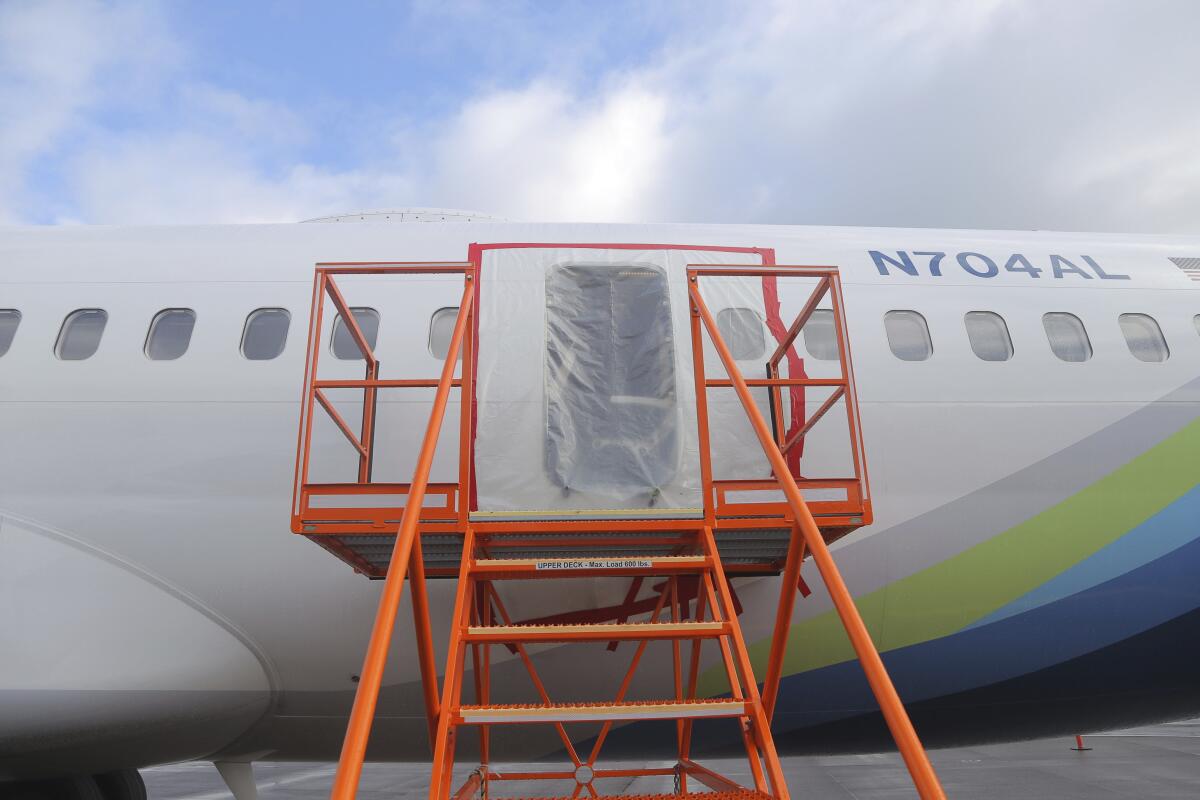Hearing seeks insight into blowout on a Boeing jet that pilots said threw the flight into ‘chaos’

- Share via
The midflight blowout of a panel from a Boeing 737 Max jet was so powerful that it blew open the plane’s cockpit door and tore off the co-pilot’s headset, and federal investigators began questioning officials from Boeing and its key supplier on Tuesday to understand how the accident occurred.
“It was chaos,” the co-pilot of that Alaska Airlines flight on Jan. 5 said in documents released by the National Transportation Safety Board.
Comments of the pilots, factory workers at Boeing and other people were released as the safety board held a rare investigative hearing into the blowout, an accident that further tarnished Boeing’s safety reputation and left it facing new legal jeopardy.
The National Transportation Safety Board’s two-day hearing, which began Tuesday, could provide new insight into an accident that caused a loud boom and left a gaping hole in the side of the Alaska Airlines jet. The NTSB also released more than 3,000 pages of documents with details about the incident.
The captain described “an explosive experience” and said he couldn’t communicate with flight attendants, according to the documents. On the intercom, he heard flight attendants talking about a hole in the plane. He decided to land the plane as quickly as possible.
The pilots landed safely back in Portland. The door plug was found in a high school science teacher’s backyard in Cedar Hills, Ore.
The accident on flight 1282 occurred minutes after takeoff from Portland as the plane flew at 16,000 feet. Oxygen masks dropped during the rapid decompression, a few cellphones and other objects were swept through the hole in the plane, passengers were terrified by wind and roaring noise, but miraculously there were no major injuries.
“This was quite traumatic to the crew and passengers,” NTSB Chair Jennifer Homendy said as Tuesday’s hearing began, speaking to anyone who may have been on the flight or knew someone aboard. “We are so sorry for all that you experienced during this very traumatic event.”
Homendy said seven passengers and one flight attendant received minor physical injuries.
The NTSB said in a preliminary report that four bolts that help secure the panel, which is called a door plug, were not replaced after a repair job in a Boeing factory, but the company has said the work was not documented. During the hearing, safety board members are expected to question Boeing officials about the lack of paperwork that might have explained how such a potentially tragic mistake occurred.
The safety board will not determine a probable cause after the hearing. That could take another year or longer. It is calling the unusually long hearing a “fact-finding” step.
Boeing supplier Spirit AeroSystems installed the door plug, a panel on many 737s that fills a cutout left for an extra exit required on some planes. The plug on the Alaska Airlines jet was removed and the bolts taken off in a Boeing factory to repair rivets.
Among the first witnesses called Tuesday was Elizabeth Lund, who has served as Boeing’s senior vice president of quality — a new position — since February.
Witnesses for Spirit and Boeing testified about safety systems and inspection processes. Lund said production of Max jets dropped below 10 per month after the Alaska Airlines blowout and has increased, but remains under 30 per month.
Lund and others also discussed the impact of COVID-19 on production and worker experience. Spirit Senior Vice President Terry George said that just five years ago, 95% of its factory employees had worked with sheet metal, but now it is 5%, and they must get more training in drilling holes and installing fasteners in aircraft bodies.
Before the pandemic, Lund added, most new hires at Boeing factories had aerospace experience, often in the military, but “coming out of COVID ... we found that considerably more of our employees did not have that aerospace experience.” She said the company has improved training since the January accident.
But others remained skeptical. “We have never been impressed with Boeing’s training at all,” International Assn. of Machinists’ representative Lloyd Catlin said. “There has been changes, but I don’t know that it’s enough.”
Lund also said Boeing is working on ways to prevent door plugs from being closed if they are not firmly secured, but she could not say when that redesign might be completed.
Later Tuesday, witnesses are expected to testify about the FAA’s oversight of Boeing. FAA Administrator Mike Whitaker has conceded that his agency’s oversight of the company “was too hands-off — too focused on paperwork audits and not focused enough on inspections.” He has said that is changing.
The plane involved had been delivered to Alaska Airlines in late October and had made only about 150 flights. The airline stopped using the plane on flights to Hawaii after a warning light indicating a possible pressurization problem lit up on three different flights.
No one from the airline was called to testify this week before the NTSB. John Goglia, a former NTSB member, said that indicates the agency has determined “that Alaska has no dirty hands in this.”
Koenig and Grantham-Philips write for the Associated Press.
More to Read
Sign up for Essential California
The most important California stories and recommendations in your inbox every morning.
You may occasionally receive promotional content from the Los Angeles Times.












